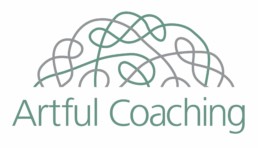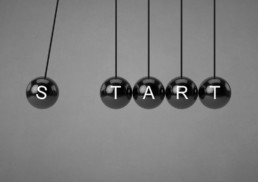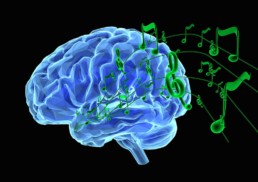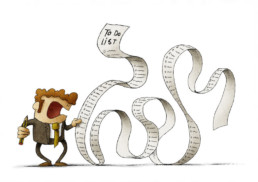Nudges
Are you familiar with “nudge theory?” In a recent newsletter from a colleague, nudge theory is described as “a way of encouraging people to do what’s in their best interest, even when other perfectly human tendencies—such as the urge to procrastinate—are conspiring against them.”
That newsletter nudged me into to writing this and sharing some of the hacks people with ADHD or other non-linear thinkers can use as nudges.
One of the best nudges is a timer. If you have a tendency to get lost in a task, setting a timer for how much time you realistically have to spend on it helps you be aware that “time is up.”

Sometimes, the best nudge is someone we admire pushing us in the right direction.
Having a staging area by the door is a way to nudge yourself to actually take with you the things you’ll need when you’re out. We have a key rack a few feet from the door. It makes it easy to hang the keys upon arriving and know where they are when we’re ready to leave.
I put a sticker on the first Monday of every month of my wall calendar. It reminds me to give our dog a flea treatment.
And then there’s Nudgemail, an easy to use reminder service that sends email prompts. This is an all-around life saver especially if you’re a busy person.
An accountability partner can be a great nudge. You each share something you want to accomplish or goal you want to attain, and you get to regularly ask each other how it’s going. (Sometimes receiving nudges is easier when you’re also giving them.)
I’m also a fan of the positive reminder. The brain is much more accepting of positive language than negative – so the next time you’re writing yourself to “Don’t forget …” try “Remember the …” instead.
Why change is so difficult
Do you remember Newton’s 1st Law of Motion? It says, an object at rest stays at rest and an object in motion stays in motion at the same speed and in the same direction unless acted upon by an unbalanced force. This is also known as the law of inertia.
Inertia. Something we all feel from time to time when we have a big project or task that feels difficult or boring. If you’re thinking inertia could be the sister of procrastination, you’d be right.
Inertia is also what makes life changes so difficult. You have a momentum going, maybe even for years, of being a certain way.

Once you get started, you can use your inertia to keep you moving in your new direction!
You do or do not do the things you’ve always done or not done. Maybe you really want to make a change, even a small change but it takes attention and practice. You need that unbalanced force Newton was so fond of.
For some, an outside force works best. Find someone willing to hold you accountable. Give them permission to check in with you regularly. An example conversation could be, “So, how’d it go with the task you intended to accomplish this week?” Then either, “Great, what helped you be successful with that?” or “Great, can you identify what got in the way? Can you avoid what got in your way last week, and be more successful this week?”
There’s an article in Entrepreneur Magazine entitled, 4 Cures for Chronic Procrastination, that nicely breaks down the process of getting through procrastination. In short:
- Narrow your focus
Just like eating an elephant, take it one bite at a time.
- Reward yourself for meeting your goals
Don’t push for perfection, if you’re doing it right more often than not, that’s a success!
- Hold yourself publicly accountable
There is nothing like knowing people are watching to keep you on task.
- Don’t lose momentum
Once you get started, keep moving!
– Sydney Metrick
Music and the Brain
“Nothing activates the brain so extensively as music,” said the late Oliver Sacks, M.D., neurologist, and author of Musicophilia. Music not only provides structure, it increases the level of dopamine in the brain. This is especially important for those with conditions like ADHD and Autism.
My friend, Ellen Hoffman, is an extraordinary woman. She’s a self-employed musician – pianist, composer, arranger, teacher, music director and producer who happens to also have attention deficit disorder. I talked with her about the amazing ways music can affect the brain and she shared the following story about a young autistic man, Ryan, she worked with at Napa State Hospital.
Like many autistic children, this boy was drawn to music. He loved listening to music – the radio, the record player, and especially to the piano. He had a sweet singing voice which had not changed yet. His favorite song to sing was Your Cheatin’ Heart. He knew all the words – even though he had no idea what they meant. He knew fragments of other songs, but this was the only song he knew all the way through. When he was in a good mood, he would sing the whole song, much like those of us who are not autistic might do.
Other than singing, he was generally non-verbal, rarely speaking more than a short sentence at a time. However, he was much more communicative thru music. If I asked him a question “Ryan, do you want a cookie?” and he was in a good mood, he would SING the answer, “Yes, I want a cookie” – in a melody all his own. Or “Ryan, how are you feeling right now?” His melodic answer might be, “Ryan is OK right now.”
I learned that if I sang to him, he was more likely to answer. If I played the piano AND sang, he was MUCH more likely to answer. The more I provided music for him, the more he related to me, and the less combative he was. Music calmed him down, made him almost happy, and improved his ability to relate to those around him, even for just a short time.
While ADHD is not nearly as extreme as Autism, music can still be vital to how someone with ADHD functions. I have one client who regularly listens to music while working. Her explanation: the music filters out the world so that she only has to filter out the music.
How music helps people with ADHD was perfectly summed up in an article I read recently called How Music Unlocked My Son’s ADHD Brain in ADDitude:
Music builds and strengthens the auditory, visual/spatial, and motor cortices of the brain. These areas are tied to speech and language, reading, reading comprehension, math, problem solving, brain organization, focusing, concentration, and attention issues.
-Sydney Metrick
Rambling Roads—the thought process of those with ADHD
Have you ever had a conversation with someone that didn’t end anywhere near the original destination? Or, maybe, you reached the original destination, just not directly.
 Some people are natural ramblers. One thought leads to another, which spurs a memory, and connects to a related story … all possibly off topic from where the conversation was originally headed.
Some people are natural ramblers. One thought leads to another, which spurs a memory, and connects to a related story … all possibly off topic from where the conversation was originally headed.
Then there’s thought distraction in which an outside comment, or something passing in the visual field, or even a sudden “pop up” of a “to do” can lead the conversation down an entirely different path.
You might also be, or know someone who is, a star at monopolization. One idea is so closely connected to the previous one, and they run together so swiftly that the other party can’t even begin to get a word in edgewise.
While rambling conversations do not require a participant to have ADHD, they are certainly more common in the ADHD world. We are especially good at blurting and interrupting – another aspect of rambling.
Perhaps something said by another triggers a thought for the person with ADHD, and the impulsivity common to those with ADHD means the thought that entered their head pops right on out of their mouth, with no filter mechanism.
These conversational journeys are not common to all who have attention deficit disorder, and do not happen in every conversation with those who do take them. Realize that anyone who has ADHD will never be neurotypical, which is defined as free from neurological atypical patterns of thought or behavior. Neurotypicals often assume that their experience of the world is the only one and the only correct one. They are wrong.
Solutions to What Might Ail You
Would you say you are easily distractible, either by things around you or competing thoughts in your head?
- Is impulsivity kind of a problem for you in relationships? Interrupting, blurting, being snappish?
- Do you get restless if you have to be in one place or focus on one less-than-fascinating thing for too long?
- Does your memory seem to be out of order when it comes to remembering names or appointments or … Hey, why am I in the kitchen anyway?
- What about time management? Do you find prioritizing a challenge? Is planning, short or long-term, a foreign concept?
Here are some tips:
Distractibility due to external factors may be addressed by finding or making a quiet spot to focus. Perhaps a white noise machine to minimize external sounds. Distracting thoughts can be important. If so, have a pad handy to jot them down for later.
 Impulsivity displayed as interrupting or blurting might also positively respond to the “I must take a note so that I remember” idea. You might also say something like, “Excuse me for interrupting, …” Snappish? Look at the common triggers and practice alternative responses.
Impulsivity displayed as interrupting or blurting might also positively respond to the “I must take a note so that I remember” idea. You might also say something like, “Excuse me for interrupting, …” Snappish? Look at the common triggers and practice alternative responses.
Restlessness takes many forms. Get familiar with your average attention span and give yourself permission to do things in short blocks of time, rotating between things that must be done. Take breaks – and return from them.
Memory issues are so frustrating, aren’t they? Calendars are a huge help. This means calendaring appointments, big tasks, and those things you want to do for yourself. Add both start and due dates for the project. Use your calendar as a commitment book and check it throughout the day.
A visible bulletin board with colored sticky notes and reminder alarms on your phone are other good tools.
If time management is one of your challenges, a calendar might help with this, too – provided you check it religiously. Setting phone reminders and responding to them can help. Also setting a timer, even a kitchen timer, for how much time you realistically can spend on a task keeps you from getting lost in hyperfocus. Finally, since it may be difficult to estimate how much time something will take, add a time cushion.
These are just a few of the tools that can make a difference…if you use them. The tool we all need to use is the honest desire to stay focused, not interrupt, remember what we’re doing, and keeping our time – if not the rest of us – organized.
If you have the desire, I have other tools I am happy to share with you. Just contact me.
-Sydney Metrick
Keep Track of Your Amazing Ideas and Precious Time
- You have a great idea in the shower and then forget it by the time you’re dressed.
- A task you thought might take an hour actually takes three.
- You sometimes get so caught up in one thing that you’re late for something else.
- Prioritizing your schedule to address every one of your “To Do’s” feels impossible.
I offer a wide array of life management tips: from budgeting your time like you do your money to a creating “Things to Not Do” list. However, tips can only get you so far – sometimes you need some extra tools in the toolbox as well.
Here are some simple and easy-to-use tools that I’ve already tried out and can recommend:

- Many of us do our best thinking in the shower, the problem is holding onto those ideas until you can act on them. Enter AquaNotes(www.myaquanotes.com), waterproof notepads that allow you to hold onto those ideas rather than rinsing them away with the shampoo. The 40 sheet, refillable pad suctions comes with a pencil and suction cups to hold them to your shower wall.
- Time Timer (www.timetimer.com) has a line of timers, watches, and applications that help you stay on track and on time.
- Planner Pads (www.plannerpads.com) offer an easy-to-use system that helps you organize, prioritize, and schedule in ways that make sense.
Even the websites are user-friendly. Check them out. Let me know if you start using any of them and tell me about your experience.
I’m also interested in knowing what other tools you recommend. Please let me know what works – and what doesn’t work – for you.
-Sydney Metrick
Solutions to What Might Ail You
- Would you say you are easily distractible, either by things around you or competing thoughts in your head?
- Is impulsivity kind of a problem for you in relationships? Interrupting, blurting, being snappish?
- Do you get restless if you have to be in one place or focus on one less-than-fascinating thing for too long?
- Does your memory seem to be out of order when it comes to remembering names or appointments or … Hey, why am I in the kitchen anyway?
- What about time management? Do you find prioritizing a challenge? Is planning, short or long-term, a foreign concept?
Here are some tips:
Distractibility due to external factors may be addressed by finding or making a quiet spot to focus. Perhaps a white noise machine to minimize external sounds. Distracting thoughts can be important. If so, have a pad handy to jot them down for later.
 Impulsivity displayed as interrupting or blurting might also positively respond to the “I must take a note so that I remember” idea. You might also say something like, “Excuse me for interrupting, …” Snappish? Look at the common triggers and practice alternative responses.
Impulsivity displayed as interrupting or blurting might also positively respond to the “I must take a note so that I remember” idea. You might also say something like, “Excuse me for interrupting, …” Snappish? Look at the common triggers and practice alternative responses.
Restlessness takes many forms. Get familiar with your average attention span and give yourself permission to do things in short blocks of time, rotating between things that must be done. Take breaks – and return from them.
Memory issues are so frustrating, aren’t they? Calendars are a huge help. This means calendaring appointments, big tasks, and those things you want to do for yourself. Add both start and due dates for the project. Use your calendar as a commitment book and check it throughout the day.
A visible bulletin board with colored sticky notes and reminder alarms on your phone are other good tools.
If time management is one of your challenges, a calendar might help with this, too - provided you check it religiously. Setting phone reminders and responding to them can help. Also setting a timer, even a kitchen timer, for how much time you realistically can spend on a task keeps you from getting lost in hyperfocus. Finally, since it may be difficult to estimate how much time something will take, add a time cushion.
These are just a few of the tools that can make a difference…if you use them. The tool we all need to use is the honest desire to stay focused, not interrupt, remember what we’re doing, and keeping our time – if not the rest of us – organized.
If you have the desire, I have other tools I am happy to share with you. Just contact me.
-Sydney Metrick
Rambling Roads—the thought process of those with ADHD
Have you ever had a conversation with someone that didn’t end anywhere near the original destination? Or, maybe, you reached the original destination, just not directly.
 Some people are natural ramblers. One thought leads to another, which spurs a memory, and connects to a related story … all possibly off topic from where the conversation was originally headed.
Some people are natural ramblers. One thought leads to another, which spurs a memory, and connects to a related story … all possibly off topic from where the conversation was originally headed.
Then there’s thought distraction in which an outside comment, or something passing in the visual field, or even a sudden “pop up” of a “to do” can lead the conversation down an entirely different path.
You might also be, or know someone who is, a star at monopolization. One idea is so closely connected to the previous one, and they run together so swiftly that the other party can’t even begin to get a word in edgewise.
While rambling conversations do not require a participant to have ADHD, they are certainly more common in the ADHD world. We are especially good at blurting and interrupting – another aspect of rambling.
Perhaps something said by another triggers a thought for the person with ADHD, and the impulsivity common to those with ADHD means the thought that entered their head pops right on out of their mouth, with no filter mechanism.
These conversational journeys are not common to all who have attention deficit disorder, and do not happen in every conversation with those who do take them. Realize that anyone who has ADHD will never be neurotypical, which is defined as free from neurological atypical patterns of thought or behavior. Neurotypicals often assume that their experience of the world is the only one and the only correct one. They are wrong.
Music and the Brain
 “Nothing activates the brain so extensively as music,” said the late Oliver Sacks, M.D., neurologist, and author of Musicophilia. Music not only provides structure, it increases the level of dopamine in the brain. This is especially important for those with conditions like ADHD and Autism.
“Nothing activates the brain so extensively as music,” said the late Oliver Sacks, M.D., neurologist, and author of Musicophilia. Music not only provides structure, it increases the level of dopamine in the brain. This is especially important for those with conditions like ADHD and Autism.
My friend, Ellen Hoffman, is an extraordinary woman. She’s a self-employed musician - pianist, composer, arranger, teacher, music director and producer who happens to also have attention deficit disorder. I talked with her about the amazing ways music can affect the brain and she shared the following story about a young autistic man, Ryan, she worked with at Napa State Hospital.
Like many autistic children, this boy was drawn to music. He loved listening to music - the radio, the record player, and especially to the piano. He had a sweet singing voice which had not changed yet. His favorite song to sing was Your Cheatin' Heart. He knew all the words – even though he had no idea what they meant. He knew fragments of other songs, but this was the only song he knew all the way through. When he was in a good mood, he would sing the whole song, much like those of us who are not autistic might do.
Other than singing, he was generally non-verbal, rarely speaking more than a short sentence at a time. However, he was much more communicative thru music. If I asked him a question "Ryan, do you want a cookie?" and he was in a good mood, he would SING the answer, "Yes, I want a cookie" - in a melody all his own. Or "Ryan, how are you feeling right now?" His melodic answer might be, "Ryan is OK right now."
I learned that if I sang to him, he was more likely to answer. If I played the piano AND sang, he was MUCH more likely to answer. The more I provided music for him, the more he related to me, and the less combative he was. Music calmed him down, made him almost happy, and improved his ability to relate to those around him, even for just a short time.
While ADHD is not nearly as extreme as Autism, music can still be vital to how someone with ADHD functions. I have one client who regularly listens to music while working. Her explanation: the music filters out the world so that she only has to filter out the music.
How music helps people with ADHD was perfectly summed up in an article I read recently called How Music Unlocked My Son’s ADHD Brain in ADDitude:
Music builds and strengthens the auditory, visual/spatial, and motor cortices of the brain. These areas are tied to speech and language, reading, reading comprehension, math, problem solving, brain organization, focusing, concentration, and attention issues.
-Sydney Metrick
Nudges
Are you familiar with “nudge theory?” In a recent newsletter from a colleague, nudge theory is described as “a way of encouraging people to do what’s in their best interest, even when other perfectly human tendencies—such as the urge to procrastinate—are conspiring against them.”
That newsletter nudged me into to writing this and sharing some of the hacks people with ADHD or other non-linear thinkers can use as nudges.
One of the best nudges is a timer. If you have a tendency to get lost in a task, setting a timer for how much time you realistically have to spend on it helps you be aware that “time is up.”

Having a staging area by the door is a way to nudge yourself to actually take with you the things you’ll need when you're out. We have a key rack a few feet from the door. It makes it easy to hang the keys upon arriving and know where they are when we’re ready to leave.
I put a sticker on the first Monday of every month of my wall calendar. It reminds me to give our dog a flea treatment.
And then there’s Nudgemail, an easy to use reminder service that sends email prompts. This is an all-around life saver especially if you’re a busy person.
An accountability partner can be a great nudge. You each share something you want to accomplish or goal you want to attain, and you get to regularly ask each other how it’s going. (Sometimes receiving nudges is easier when you’re also giving them.)
I’m also a fan of the positive reminder. The brain is much more accepting of positive language than negative – so the next time you’re writing yourself to “Don’t forget …” try “Remember the …” instead.
Check Please
You know that phrase, “It seemed like a good idea at the time”?
In the western film, "The Magnificent Seven," Steve McQueen, in the role of Vin, gives an example worth watching.
The thing is, what seems like a good idea at the time or in the moment, may have consequences that, in retrospect, lead more to “What was I thinking?”

We’re all plagued by impulsivity from time to time; but for those with ADHD, impulsivity may be an ongoing challenge. Fortunately, there is a process that can broaden the sense of time so that actions taken in the present are seen to have repercussions in the future. Think of it as a future check.
First, you have to be aware that you are making a decision about something. This can actually be the hardest part. Instead of just going along with the moment, stop and acknowledge that you are actually making a decision to do/not do something.
Call this your decision point. It’s like standing at a fork in the road and determining the way to go. Be there two or multiple options, you are now at step two in the process.
Second, use “if/then” thinking to consider your choices. Examples would be, “If I hang out on the internet instead of writing my newsletter, what would that mean to me and my business tomorrow or next week?” Or, “Those lemon bars are my favorite dessert. If I eat four of them (which would be so delicious and my mouth is watering) how will I feel later today and will my pants fit tomorrow?” Or, “How about I buy myself one too? Will I be able to pay my mortgage at the end of the month?”
Those of us who are not linear thinkers tend to make “in the moment” decisions based on what feels good right then. However, this month, with all the opportunities for buying and eating more than we need or can afford, it’s an excellent time to develop the habit of stopping at a decision point and considering consequences.
-Sydney Metrick
“Now where did I put my…?”
Does this ever happen to you? You’re carrying a few bags of groceries from the car to the house. In a hurry to go out again later that day, you’re distressed to discover your keys are nowhere to be found.
There are only so many things you can fully attend to at a time. When you’re engaged in a conversation, or have ten things on your mind something as “trivial” as where you set something down may not shoot right past your short term memory.
My uncle Leon would have his glasses pushed up on top of his head. Look all over the house for them and offer me a quarter if I could find them for him. That was the easiest quarter I ever made. Like Leon, everyone misplaces things from time to time-you put your keys in your pocket because you’re carrying a few bags, hang up your jacket and later wonder where your keys are, or put your phone down to get some information in another room then return and don’t remember where you set the phone.
Two solutions. Places where you always (okay almost always) put certain items, like keys, phone, wallet, shoes. It’s kind of like having the address for them. Once you develop the habit, chances are lots higher that you’ll find your items where they belong.
But sometimes you won’t put things where they belong, right? Even if you’re in a rush, stop. Sit down. Close your eyes and breathe. Think about what you were doing when you last had the item. Recreate your steps. Do this as calmly as possible.
How do you decide where something “belongs” anyway? Have you ever put something important in a safe place and then forgotten just where that place is? Again, having a special safe place that you use all the time can make a huge difference. Trust me. I still haven’t found two hundred dollar bills I put safely away last fall.
Wouldn’t it be Nice if…
Let’s play a game. It’s called “Wouldn’t it be nice if…”
Here’s how to play-- think of something specific you want to do, have, or be. Add that to the framework. For example, “Wouldn’t it be nice if I got eight hours of sleep,” or “Wouldn’t it be nice if it was easy for me to prioritize.”
Sure, there are some things that would be nice … winning the lottery, finding the fountain of youth, having a chauffeur. But those may be just a bit beyond your reach. However, sufficient sleep or being able to prioritize are totally doable. That is if you really want them and are ready to make it happen.
John Asseraf said, “If you’re interested you’ll do what’s convenient; if you’re committed, you’ll do whatever it takes.”
Sometimes it’s easier to know what you don’t want than what you do want. So get clear about what you really want. Can you imagine being the person who does what it takes to have what you say you want?
- Do you believe you can have it, that you deserve to have it?
- Do you really want it or just think it would be nice?
- Finally, are you ready to do whatever it takes?
Let’s look at your answers:
- If the answer to #1 is “not sure” or “no” you might want to start smaller and work your way up to your bigger, ultimate goal.
- How about #2? Do you think you “should” want to do, have, or be whatever you have in mind? For example, you have friends with new cars and you have an old Toyota that you actually love, but wonder what kind of statement it makes about you. I am anti-should, so don’t let others tell you what you feel. On the other hand, it never hurts to get an outsider’s opinion on how your image is impacting your reputation.
- Number #3 is easy. If you’re ready, it’s good to have support. Here’s where I can help. As a coach, I help you clarify your goals, create realistic action plans, schedule the steps, work through obstacles, and get results.
The Magic of “What if…”
Are you satisfied with the results of your actions (or lack of actions)?
Consider this cycle:
- You hold certain beliefs, such as “I’m not a person who…” or “I can’t use a calendar.”
- When you think about doing one of those things, you feel apathy or even defiance.
- The unpleasant or negative feelings lead to avoiding actions that would have furthered you towards a goal.
- You don’t like the results you do get and possibly feel a bit of self-recrimination.
The results become evidence and the cycle continues.
Beliefs lead to thoughts which bring about feelings that influence behaviors and consequently results.
When you repeatedly get results that do not support your goals or your happiness it’s time to stop and consider what could be in the way. What if you interrupt the “I’ll do that later…” or “It’s too hard…” or any other sad excuse? What if you notice when you have a thought that is likely to interfere with an intended action? What if you reflect on how you’ll feel later if you avoid following through with your intention? What if you disregard the excuses and take the intended action anyway?
What if you give yourself the chance to do more of what you say you want for yourself and be more of who you say you want to be?
If you want different results, then you need different actions. Different actions require different feelings, and different feelings need different beliefs. So, when you hear yourself thinking “I’m not …” STOP.
You are, you can, and you will.
Routine or Ritual?
Habits and routines created with intention can make life easier in so many ways. I don’t mean the unconscious habits of going for a snack when you’re bored or throwing clothes on the chair rather than hanging them up. Those are the habits that most people say they’d like to change.
What I’m talking about are the productive behaviors you want to change the problem behaviors to. I’m also including other positive routines and habits – such as regular sleep and wake time, paying bills every Friday, that kind of thing. For example, I have a morning routine that goes breakfast, exercise, shower and dress, work. Sometimes I have an early client and have exercise or shower after that. The actions of the routine may get shuffled but not neglected because they’ve become habitual.
Now with a ritual you are adding an additional element—the conscious intention of the behavior helping you be more of the person you wish to be. Here’s an example that uses the process of ritual:
Intention: Organizing a space in which you can find things, get things done, and keep what’s important to you safe. Hold the intention of creating your space as a sanctuary where you can be comfortable and focus on what is meaningful.
Planning: Schedule a block of time to look at all of the things in your space. During this time, you will make a decision about every item in your space. If something has no use or meaning, or is no longer important to you, consider letting it go. Some things will be tossed, some given away, and some perhaps stored elsewhere because they are rarely used. Next, look at what will stay – the things you want to keep and use all the time. Think about where it makes the most sense to put the items you’ve decided are special to you and support your intention.
Preparation: Your first action step is the clearing and de-cluttering. A cleansing process is often done to make way for something new. After clearing, find the right kinds of containers for the things you have. Now, take a break.
Manifestation: Set aside a morning or afternoon for the ritual. Enter the room and close the door. Sit down and focus on your intention.
Select one type of object—say books. As you recognize in what way they reflect who you are and what’s important to you, you can claim them as power objects. Put them in the areas you’ve decided upon.
To close the ritual, imagine doing what you will be doing in each area of the room. Do you feel better, worse or, the same as before? Make sure you feel good everywhere. Take a photograph of your space.
Integration: Put the photograph on the wall or in your journal. Use it as a daily or weekly reminder as perhaps the first step of a maintenance ritual.
Are you the driver or the passenger?
You know how when you're in a car riding “shotgun” and the driver’s going dangerously fast, you press your foot against the floor really hard as if there was a brake pedal there?
When someone else has the controls you’re along for the ride. If the driver makes a risky move, there’s not much you can do.
How is this relevant to your life? Well, let’s talk about “locus of control.”
If you feel you have no control over the events in your life, in psychological terms that would be called having an external locus of control. When things don’t go as you wish, you might blame bad luck, injustice, or even “Mercury in Retrograde.” On the other hand, with an internal locus of control you feel that you, yourself, are responsible for outcomes. And if not the outcome itself, your response to it. Think of it as responsibility.
Even when you have specific goals and well-thought out plans things may not work out as you intend. Perhaps you had some internal obstacles you couldn’t foresee…not your fault. Or there was some sort of glitch that interfered when you were just tooling along perfectly, like road work that caused a detour and added minutes to your journey. Again, no one to blame. The road workers hadn’t come up with an elaborate plan just to frustrate you.
Life doesn’t always seem to comply with our wishes and our best intentions often go astray. These times are opportunities. Use them as lessons to either prevent similar future problems that might arise in the future, or to practice letting go of expectations and focusing on all the things that are right in your life.









